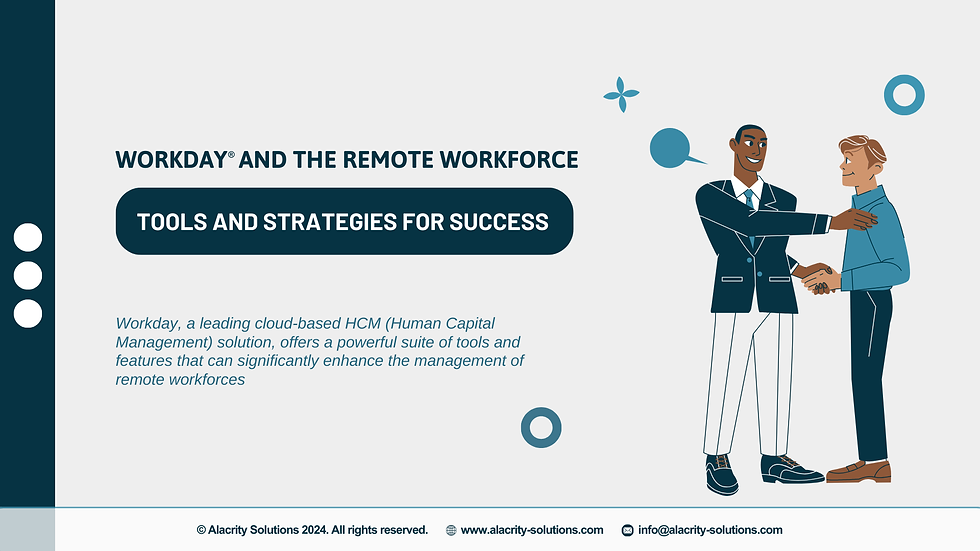Workday and the Remote Workforce: Tools and Strategies for Success
- Bumbble Beast
- Jan 17
- 4 min read

The shift to remote work has transformed the way businesses operate. With distributed teams becoming the norm, organizations need powerful tools and strategies to manage their workforce effectively. Workday, with its cloud-based platform and robust capabilities, has emerged as a critical enabler for managing remote workforces. From fostering collaboration to ensuring compliance, Workday equips organizations with the tools they need to succeed in a hybrid or fully remote work environment.
This blog explores how Workday empowers businesses to thrive in the remote work era, along with strategies for optimizing its capabilities for maximum impact.
The Rise of Remote Work
Remote work has evolved from a temporary solution during the pandemic to a long-term business strategy. However, managing a dispersed workforce comes with challenges such as maintaining productivity, ensuring employee engagement, and managing compliance across regions. Organizations must also address workforce planning, payroll complexities, and security risks—all while fostering collaboration and communication.
Workday’s comprehensive suite of tools is uniquely designed to address these challenges, helping organizations manage their people, processes, and data seamlessly, regardless of location.
Key Workday Tools for Supporting a Remote Workforce
1. Workday Human Capital Management (HCM)
Workday HCM offers robust solutions to support remote employees:
a. Employee Engagement: With features like pulse surveys and employee feedback tools, organizations can monitor and improve employee morale.
b. Self-Service Portals: Remote workers can access personal data, benefits, and pay information, empowering them to manage their needs independently.
c. Talent Management: Workday enables effective goal setting, performance reviews, and career development planning, keeping remote teams aligned and motivated.
2. Advanced Workforce Planning
Remote work often requires rethinking workforce structures. Workday’s Adaptive Planning tool helps organizations model various scenarios, such as shifting teams to remote operations or reallocating resources. Businesses can forecast labor costs, assess productivity, and optimize staffing decisions, ensuring they remain agile in a dynamic environment.
3. Learning Management and Development
Upskilling and reskilling are critical in a remote setting. Workday’s Learning Management System (LMS) supports:
a. Virtual Training: Delivering engaging online courses for employees to grow their skills.
b. Personalized Learning Paths: Tailoring content to individual employee roles and career goals.
c. Collaboration Tools: Facilitating peer-to-peer knowledge sharing through virtual workshops and communities.
This ensures that remote employees have access to continuous learning, improving engagement and long-term retention.
4. Enhanced Collaboration and Communication
Workday integrates seamlessly with collaboration tools like Microsoft Teams, Slack, and Zoom, ensuring streamlined communication for remote teams. Through these integrations, employees can schedule meetings, collaborate on projects, and access key Workday functionalities directly within their preferred communication platform.
5. Global Compliance and Payroll Support
Managing payroll and compliance for remote teams across multiple locations is complex. Workday’s Payroll and Time Tracking solutions help organizations:
a. Automate payroll processes across regions.
b. Ensure compliance with local labor laws and tax regulations.
c. Track time accurately for remote workers, regardless of location.
By simplifying compliance, Workday reduces administrative burdens and ensures consistency in managing a global workforce.
6. Real-Time Analytics and Insights
Workday’s reporting and analytics tools provide leaders with real-time visibility into their workforce. Dashboards can track remote team productivity, employee satisfaction, and other KPIs, helping leaders make data-driven decisions. For example, managers can analyze turnover rates among remote workers or identify engagement challenges to address proactively.
Strategies for Maximizing Workday’s Potential in Remote Work
1. Invest in Change Management
Implementing Workday tools for remote teams requires buy-in from employees and leaders. A clear change management strategy, including training and communication, ensures that teams understand and adopt new processes effectively.
2. Leverage Automation
Automate repetitive tasks like time-off approvals, payroll adjustments, and data reporting. This reduces administrative overhead and allows HR and management teams to focus on strategic initiatives like employee well-being and productivity.
3. Foster a Culture of Transparency
Use Workday’s self-service tools to promote transparency in company policies, performance goals, and compensation structures. When employees have clear visibility into their career progression and organizational priorities, they are more likely to stay engaged and aligned.
4. Focus on Data Security
With sensitive HR and financial data stored in the cloud, security is paramount. Workday provides built-in security features like encryption, multi-factor authentication, and audit trails to ensure data is protected from cyber threats. Businesses should regularly review security configurations to safeguard remote operations.
Real-World Success Stories
Case Study 1: Enhancing Employee Engagement
A global software company transitioned to a fully remote model and used Workday’s HCM tools to maintain employee engagement. By deploying pulse surveys and automating performance reviews, the company saw a 20% improvement in employee satisfaction and a 30% reduction in turnover within the first year.
Case Study 2: Streamlining Payroll for a Remote Workforce
A multinational healthcare provider with employees in over 20 countries used Workday Payroll to simplify global payroll processing. Workday AMS support helped the organization automate tax compliance, cutting payroll errors by 50% and reducing processing time by 40%.
Case Study 3: Scaling Operations During Growth
A tech startup that adopted a hybrid workforce model leveraged Workday’s workforce planning tools to optimize headcount and allocate resources effectively. Workday’s analytics provided insights that helped the company scale operations from 300 to 1,000 employees in under two years.
Conclusion
As remote work becomes a permanent fixture of the modern workplace, organizations must adapt to ensure continued success. Workday provides the tools and strategies needed to manage remote teams effectively, from engaging employees to maintaining compliance and optimizing operations. By leveraging Workday’s powerful features and adopting best practices, businesses can not only overcome the challenges of remote work but also unlock new opportunities for growth and innovation.






Comments